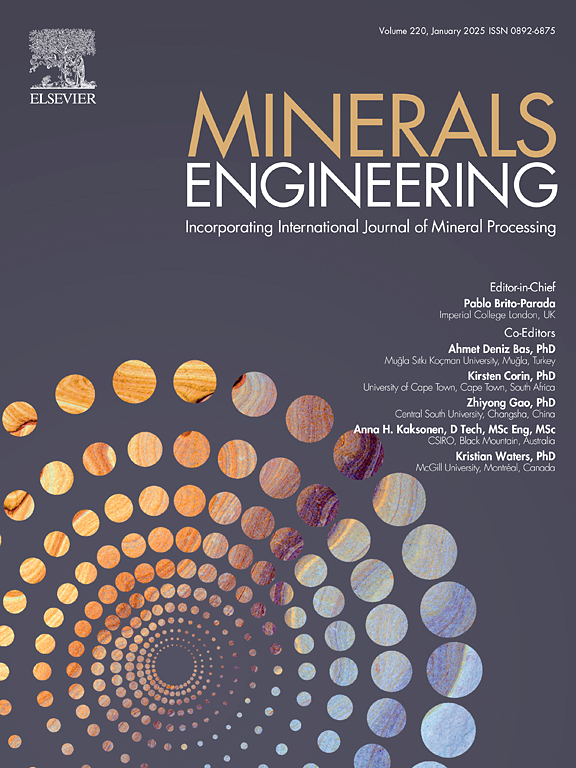含锌和镍次生硫化物的特征和浸出方案
IF 4.9
2区 工程技术
Q1 ENGINEERING, CHEMICAL
引用次数: 0
摘要
研究人员对一种富含镍(千枚岩)和锌(闪锌矿)以及混合镍-铁-硒硫化物的硫化二次原料进行了表征,并在利用空气或氧气、H2SO4、温度范围和气体流速的大气直接酸浸出系统下对其浸出行为进行了研究。目的是研究原材料中主要元素(镍,15 wt%;锌,16 wt%)的可萃取性,是镍和锌可同时萃取,还是材料更适合选择性浸出,从而影响后续工艺选择。在 1 升和 0.5 升系统中进行了两个互补浸出系列的批量浸出实验。除了使用 O2(g)的实验外,镍并没有从原料中的镍硫酸盐中明显提取出来。在锌萃取结束、溶液氧化还原电位(ORP)升高至约 450 mV(与 Ag/AgCl 相比)之前,镍不会轻易溶解,只有在温度=90 °C、pH=1 的条件下,t = 24 小时时,萃取率才达到约 50%。浸出残渣中的锌含量紧随 ORP 的变化,在 E=471 mV(相对于 Ag/AgCl)时达到最小值(0.1 wt% Zn)。ZnS 最快速的浸出动力学是过量酸,其次是 O2(g)实验。在响应面设计实验(T=30、50、70 °C;m(H2SO4)/m(原料) = 0.6、0.9、1.2 g/g)中观察到了适当的动力学,可以在 < 6 小时内萃取出锌,因为在几种实验条件下,从高温(90 °C)和有限的恒定酸度(pH 值为 1)到低温(T=50 °C)和高过量酸度,都有可能在萃取出大部分锌(99 %)的同时生产出升级的 NiS(20 wt%)。实验表明,在常压工艺中可以选择性地萃取锌,同时在浸出残渣中保留大部分镍。选择性萃取锌可以将镍和锌分离成不同的原料,然后再进行加工:锌工艺中的锌流和镍冶炼厂中的含镍残渣。本文章由计算机程序翻译,如有差异,请以英文原文为准。
Characterization and leaching options of a Zn and Ni-containing secondary sulfide
A sulfidic secondary raw material rich in Ni (millerite) and Zn (sphalerite) as well as mixed Ni-Fe-S sulfides was characterized and investigated for its leaching behavior under atmospheric direct acid leaching system utilizing air or oxygen, H2SO4, temperature ranges, and gas flow rates. The goal was to investigate extractability of the main elements (Ni, 15 wt% and Zn, 16 wt%) in the raw material whether both Ni and Zn could be extract simultaneously, or whether the material is more amenable to selective leaching, impacting the subsequent process options. Batch leaching experiments were performed in a 1 L and 0.5 L systems in two complementary leaching series. Ni was not appreciably extracted apart from the Ni sulfates present in the raw material apart from the experiments utilizing O2(g). The Ni dissolution did not readily occur until Zn extraction was finished and solution oxidation–reduction potential (ORP) increased to ca. 450 mV (vs. Ag/AgCl), and only reached ca. 50 % extraction at t = 24 h in T=90 °C and pH=1. The leach residue Zn content closely followed the ORP, achieving a minimum (0.1 wt% Zn) at E=471 mV (vs. Ag/AgCl). The most rapid leaching kinetics for ZnS was with excess acid, followed by experiments with O2(g). Decent kinetics were observed in response surface design of experiments (T=30, 50, 70 °C; m(H2SO4)/m(Raw material) = 0.6, 0.9, 1.2 g/g), allowing Zn extraction in < 6h. as it was possible to produce upgraded NiS (20 wt%) while extracting most of the Zn (99 %) under several experimental conditions, ranging from high T (90 °C) and limited constant acidity (pH 1) to low temperature (T=50 °C) and high excess acidity. It was shown that it is possible in an atmospheric process to selectively extract Zn while keeping majority of Ni in the leach residue. Selective extraction of Zn allows separation of Ni and Zn into separate materials feeds to be subsequently processed: Zn stream in a Zn process, and Ni-containing residue in a Ni smelter.
求助全文
通过发布文献求助,成功后即可免费获取论文全文。
去求助
来源期刊

Minerals Engineering
工程技术-工程:化工
CiteScore
8.70
自引率
18.80%
发文量
519
审稿时长
81 days
期刊介绍:
The purpose of the journal is to provide for the rapid publication of topical papers featuring the latest developments in the allied fields of mineral processing and extractive metallurgy. Its wide ranging coverage of research and practical (operating) topics includes physical separation methods, such as comminution, flotation concentration and dewatering, chemical methods such as bio-, hydro-, and electro-metallurgy, analytical techniques, process control, simulation and instrumentation, and mineralogical aspects of processing. Environmental issues, particularly those pertaining to sustainable development, will also be strongly covered.
 求助内容:
求助内容: 应助结果提醒方式:
应助结果提醒方式:


